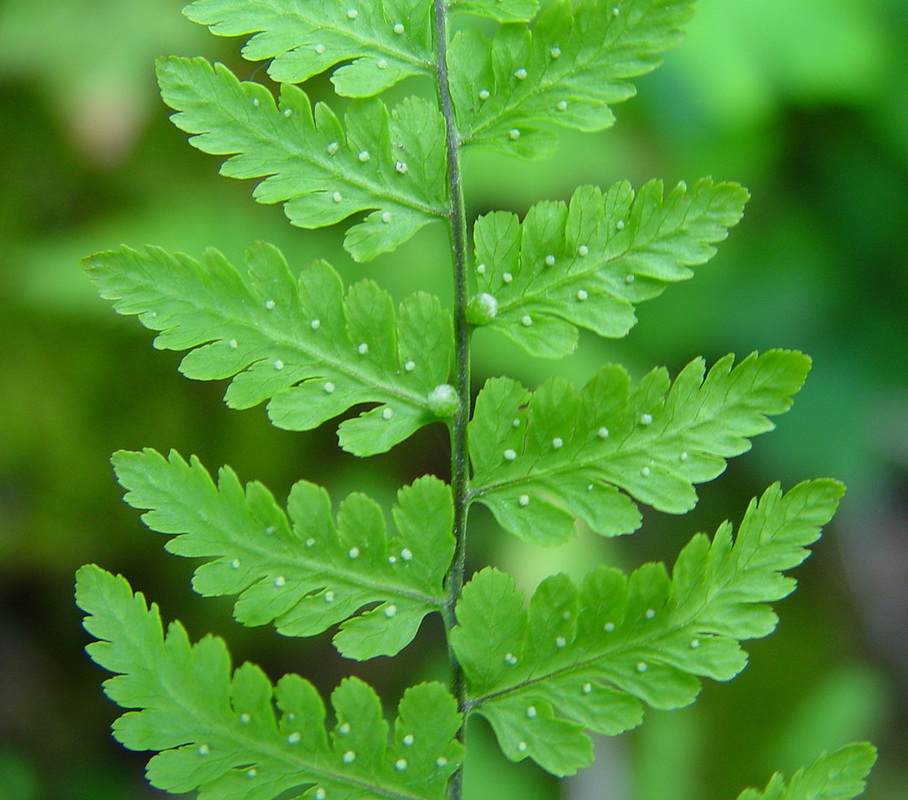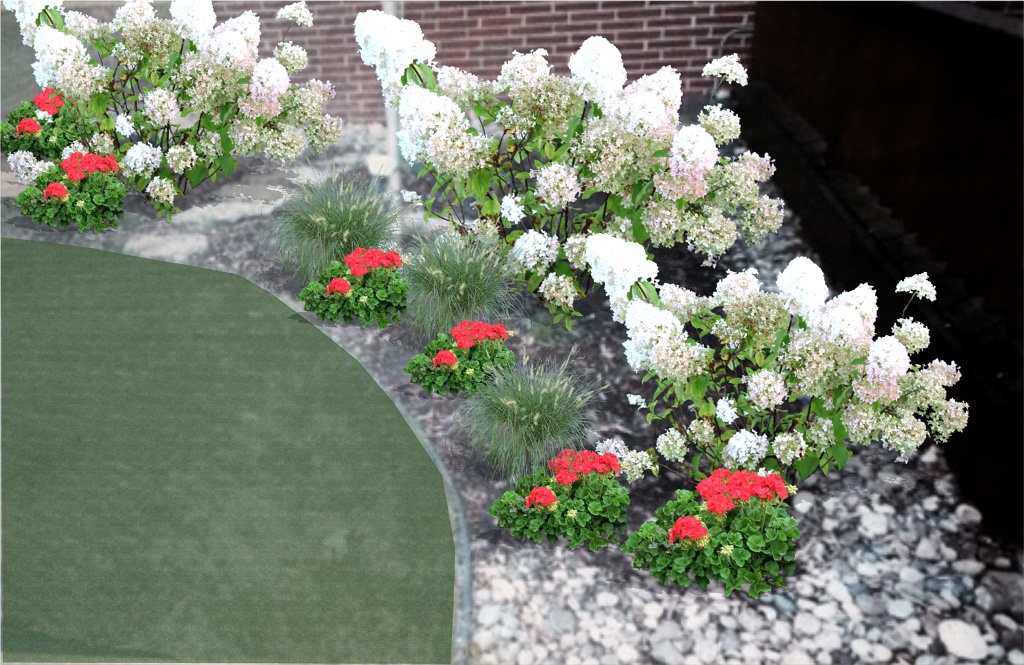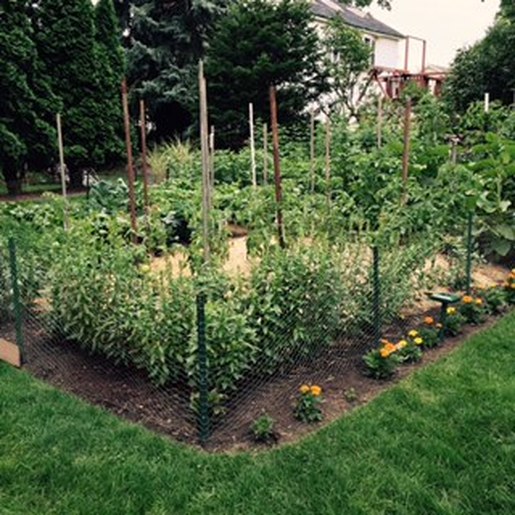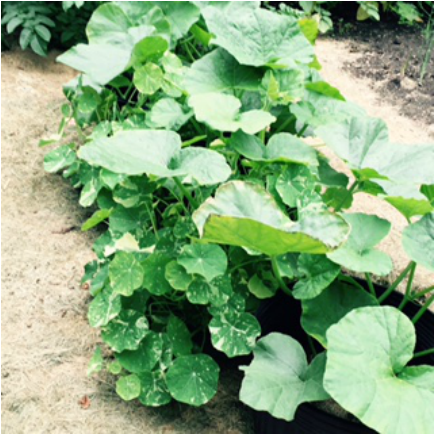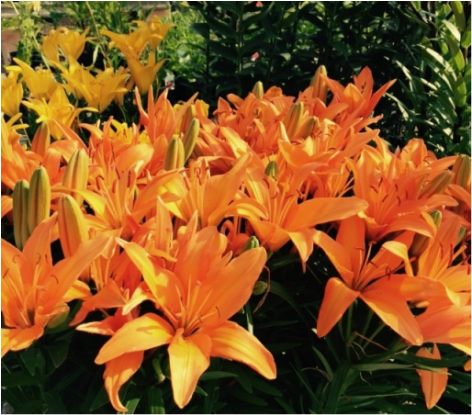|
Back in the mid-1800's parts of England were gripped by 'pteridomania', also known as fern fever. Victorians were fascinated by the diversity in appearance, cultural requirements, and how they reproduced. Greenhouses and ferneries were constructed to house the vast collections brought from far travels. We've got a touch of pteridomania here at BGC and hope you'll catch it, too! Whether you intend to collect many varieties to create your own outdoor fernery, or simply enjoy a couple favorites, ferns can be mixed into the shade garden among broad-leaved hostas and other shade lovers. Ferns in general like moist, organic soil in part to full shade. We have ten varieties that are hardy here is Wisconsin to get you started. Here we feature seven of them. Let's begin with the Athyrium group of ferns which includes the popular Japanese painted fern. Above is Athyrium x 'Ghost' which is a cross between the Japanese Painted fern and the Lady fern. 'Ghost' has upright silver fronds that can reach 24". It really catches the eye in the shade garden. * 'Lady in Red' (Athyrium filix-femina) is stunning when back lit by dappled sunlight. Grows 18-30". * If you want something unusual, Athyrium 'Ocean's Fury' is for you. Look carefully at the photo above and you'll see that the tips of each leaflet are forked or crested. 'Ocean's Fury' makes a lovely 3'x3' mound of gray-green lacy foliage. * One more from the Athyrium group to mention is 'Branford Beauty'. A cross between the Japanese Painted and Lady ferns gives it colorful leaves and a soft look. Give this fern morning sun to get the best leaf coloring. Grows 18"x18". * Maidenhair Fern, Adiantum pedatum, is a Wisconsin native and has delicate fan-shaped fronds on wiry, black stems. Grows 12-16". * Berry Bladder Fern, Cystopteris bulbifera, is a delicate looking fern that spreads by bulblets instead of spores and can grow to 12" tall. * This last one is a staff favorite and sure to win you over. Brilliance Autumn Fern, Dryopteris erythrosora, has coppery-red new foliage that turns dark green when mature. Grows 18-24" and spreads by runners.
0 Comments
7/22/2015 0 Comments Perennial Pick: Summer AlliumsMany of us are familiar with the spring-blooming alliums - the big purple balls atop of tall bare stems. With names like 'Gladiator', 'Globe Master', 'Mount Everest' and Allium giganteum, you can expect them to make a big impression in the garden. Planted as bulbs in the fall or potted perennials in the spring, they send up their leaves in early spring, followed by huge balls of purple or white that shoot up and open like fireworks. Even as they dry on the stem, the flowers add interest to the garden. Lesser known alliums include two of my favorites: Allium 'Summer Beauty'(shown below) and Allium 'Lavender Lollipop' (shown above). They bloom mid to late summer and though smaller in stature, they add a whimsical touch lasting well into the fall. 'Lavender Lollipop' (Allium x 'Windy City') is a new introduction from Brent Horvath from Intrinsic Perennial Gardens located in our backyard in Hebron, IL. It's a deeper shade of purple, floriferous, and stands tall on 15-18" stems. Like other alliums, they need full sun, are drought tolerant and deer resistant. Allium x 'Summer Beauty' is a good companion to several other perennials such as hardy geraniums (above). * The deep purple of Stachys officinalis or Salvia 'Cardonna' along with the blue spruce make a nice backdrop for these allium clumps. * Alliums planted in drifts with Calamintha nepeta 'White Cloud'. * Grasses like Seslaria autumnalis (Autumn moor grass) or Sporobolis heterolepis (Prairie dropseed), Echinacea (coneflowers), and Perovskia (Russian sage) create a natural prairie-like setting for summer alliums.
Though they look like their cousin, common chives, summer alliums are ornamental onions, not edible. They have a sterile seed so they stay well behaved in their clumps, Stop by and pick up an allium or two and add some whimsy to your garden. - Tracy Hankwitz, BGC Store Manager 7/15/2015 1 Comment Design Study: A Perennial BorderMidsummer finds many perennials at their peak, so I recently took the opportunity to visit a nearby perennial garden. The garden belongs to BGC Staff member, Sharon Marrano, and has a few design examples that we all can learn from and apply to our own perennial gardens. * The white fence provides a clean backdrop showing off plantings on each side. DESIGN TIP #1: Spread out. Allow enough space for each type of perennial to do it's thing. Here, red monarda, yellow daylily, and almost-ready-to-bloom Russian sage, each have 2.5-3 feet of space to fill. Also notice the staggered height of the three plants. * DESIGN TIP #2: Vary flower form. The flowers of the lily, allium, and phlox (in back) are all shades of pink. It works in this space because each variety has a different flower shape. * DESIGN TIP #3: Hide spent foliage. Oriental and Asiatic lilies are lovely when in bloom, but once they are finished, the foliage left behind can be an eyesore. Here Sharon has planted interplanted ferns with the lilies to disguise the declining leaves and stems of the lilies. * DESIGN TIP #4: Vary leaf texture. When pairing perennials in the garden, it's important to consider the leaf texture. If done well, the foliage will continue to be interesting long after the flowers are done blooming. The coneflowers (on the right in the photo above) have a medium leaf texture. The bright green grass-like leaves of the daylily on the left provide good contrast. To the left of the daylily is a large clump of tall sedum (shown below) bringing fall color as well as a round, fleshy leaf texture. DESIGN TIP #5: Let plants intermingle. Yellow yarrow and blue balloon flowers (above) make good partners coming from opposite sides of the color wheel. Instead of manicuring them into their own clumps, Sharon has allowed them to intermingle for a cottage garden look. * DESIGN TIP #6: Play with color. The soft gray foliage of Russian sage makes a nice background for the pastel pink and yellow daylily (above). Bold colors catch the eye in this grouping of red monarda, purple delphinium, and yellow coreopsis (below). I'm off to the garden to move a few of my perennials. Until next time, happy gardening! - Tracy Hankwitz
Horticulturist & Store Manager of Burlington Garden Center 7/15/2015 1 Comment Project: Homemade Vanilla ExtractDo you want to know the secret for yummy baked goods?Homemade vanilla extract. It's easy to make and so worth the wait. Cut two vanilla beans into thirds and place them in an airtight bottle or jar. We love these sealed, vintage-looking bottles that are perfect for this project (and available here at BGC.) Fill the bottle with vodka, seal, and place in a cool, dry place for at least 4 months. Enjoy!
Don't you just love befores and afters? Take a look at this 'before' photo: After talking with the homeowner, we came up with three options for that corner: White 'Bobo' hydrangeas, blue fescue grasses, and requested red geraniums create a patriotic garden surrounding the flagpole. * In this design, Japanese willow (Salix 'Hakuro Nishiki') takes center stage and softens the brick corner. * Three clumps of Feather Reed grass (Calamagrostis 'Karl Foerster') add movement and will provide a great look into the fall with 'Autumn Joy' sedum.
* This is an example of our NEW landscape design service's 'Quick Pic' option. If you are ready to spruce up your yard but not sure what to plant, we'd love to talk to you about the possibilities and design a plan for you to plant. Stop in or give us a call at 262.763.2153. Ask for Belinda or Tracy. Learn more here.  Limelight hydrangea hedge - photo source: www.soonerplantfarm.com Limelight hydrangea hedge - photo source: www.soonerplantfarm.com Need some privacy in your backyard, but aren't excited about utilizing the traditional privet, boxwood or arborvitae? Why not try planting a hydrangea hedge. There are two wonderful varieties of panicle hydrangeas (cone-shaped blooms) that reach 6'-8' x 6'-8' wide, making them ideal for a privacy hedge. Limelight hydrangea (Hydrangea paniculata 'Limelight') has green blooms on old wood that fade to pink and is adaptable to various soil types. The Quick Fire hydrangea (Hydrangea paniculata 'Quick Fire') has white blooms on new wood that transition to a deep pink, and is the first panicle hydrangea to bloom each summer. * Looking for some privacy for a patio or pool area? Why not try either a Tickled Pink hydrangea (Hydrangea paniculata 'HYPMAD II') or a White Diamonds hydrangea (Hydrangea paniculata 'HYPMAD I'). At 4'-5' x 5'-6' wide, both are the perfect height for this type of landscape application. The curved petals on the blooms of Tickled Pink start out white and change to pink for a lace-like appearance, while White Diamonds start out white and fade to a pale pink. Utilizing hydrangeas for privacy not only provides you with the necessary screening, but you also can enjoy cut flowers from mid-summer to fall. Leaving the blooms intact until spring also adds some "winter interest" to your landscape.
Remember this? This was Marty's garden a month ago in early June. This is Marty's garden now. Following are a few tips that you can use this month in your own garden: Lesson #1: Mulch! Using straw or dried grass clippings around your plants, especially tomatoes, will retain moisture, reduce weeds, and help prevent early blight. * Lesson #2: At planting time Marty used recycled nursery pots with no bottoms around her squashes and cucumbers to protect them from rabbits. She leaves them in place to make watering easier. * Lesson #3: Companion planting. Nasturtiums planted with cucumbers and squashes deters squash bugs and cucumber beetles. Add nasturtium leaves to salads for a peppery flavor. Plant sage with broccoli to repel cabbage moths. * Lesson #4: Stake tomato plants. She uses a variety of repurposed supports for her indeterminate tomato plants. Growing them in this way allows more light and good air flow for better fruiting.
* Watch for more tips next month. 7/2/2015 0 Comments Lily Daze of SummerIt's early July and lilies are at their finest. You can't walk by them in the garden without noticing them. These prima donnas demand attention. Following are the varieties we are excited about this year and have just arrived at BGC: 'Tiny Skyline' (shown above) is from the new Lily Looks series developed in the Netherlands. Bred for their small stature makes them perfect for growing in a container on the patio. These Asiatic lilies will bloom 2-4 weeks because of their high bud count. Plant in full sun/part shade in the front of the border. * Lily Looks 'Tiny Bee' is small in height (10-12") but it's flowers are big and beautiful. Blooms will last longer if planted in a spot that receives morning sun and afternoon shade. * Deep red flowers appear just in time for the celebration of our country's independence on Lilium 'American Revolution'. They stand tall and proud at 48" and seldom need staking. * Lilium 'Strawberry Vanilla Latte'. This lovely lady's claim to fame is that she is pollenless! At 24" tall, her double petals are a mix of strawberry and cream. * Wow! Gotta have one of these! The petals of this oriental lily, 'Distant Drum', are rose-pink, double, and can reach 7 inches in diameter. Grows to 30" in full sun and makes a great cut flower. * Two favorites, 'Casa Blanca' and 'Stargazer', round out our summer collection. Both are fragrant and are stunning in flower arrangements.
DESIGN TIP: Lilies certainly add drama to the garden, so use sparingly, scattering clusters of them through the beds like exclamation points. Plant other perennials in front of them to hide their foliage after blooming (it's not very becoming to look at). ANOTHER TIP: Lily blossoms will last longer if you remove the pollen anthers after the flowers open. * |
|
|
STORE INFO
5205 Mormon Road Burlington, WI 53105 262.763.2153 |







